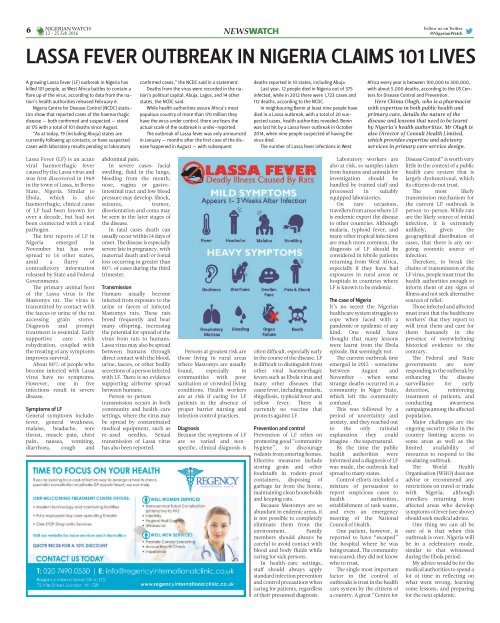Create successful ePaper yourself
Turn your PDF publications into a flip-book with our unique Google optimized e-Paper software.
6<br />
<strong>NIGERIAN</strong> <strong>WATCH</strong><br />
12 - 25 Feb 2016<br />
NEWSWatch<br />
Follow us on Twitter<br />
@NigerianWatch<br />
Lassa FEvEr outbrEak IN NIgErIa cLaIms 101 LIvEs<br />
A growing Lassa Fever (LF) outbreak in Nigeria has<br />
killed 101 people, as West Africa battles to contain a<br />
flare up of the virus, according to data from the nation’s<br />
health authorities released February 6.<br />
Nigeria Centre for Disease Control (NCDC) statistics<br />
show that reported cases of the haemorrhagic<br />
disease — both confirmed and suspected — stood<br />
at 175 with a total of 101 deaths since August.<br />
“As at today, 19 (including Abuja) states are<br />
currently following up contacts, or have suspected<br />
cases with laboratory results pending or laboratory<br />
confirmed cases,” the NCDC said in a statement.<br />
Deaths from the virus were recorded in the nation’s<br />
political capital, Abuja, Lagos, and 14 other<br />
states, the NCDC said.<br />
While health authorities assure Africa’s most<br />
populous country of more than 170 million they<br />
have the virus under control, there are fears the<br />
actual scale of the outbreak is under-reported.<br />
The outbreak of Lassa fever was only announced<br />
in January — months after the first case of the disease<br />
happened in August — with subsequent<br />
deaths reported in 10 states, including Abuja.<br />
Last year, 12 people died in Nigeria out of 375<br />
infected, while in 2012 there were 1,723 cases and<br />
112 deaths, according to the NCDC.<br />
In neighbouring Benin at least nine people have<br />
died in a Lassa outbreak, with a total of 20 suspected<br />
cases, health authorities revealed. Benin<br />
was last hit by a Lassa fever outbreak in October<br />
2014, when nine people suspected of having the<br />
virus died.<br />
The number of Lassa fever infections in West<br />
Africa every year is between 100,000 to 300,000,<br />
with about 5,000 deaths, according to the US Centers<br />
for Disease Control and Prevention.<br />
Here Chima Olugh, who is a pharmacist<br />
with expertise in both public health and<br />
primary care, details the nature of the<br />
disease and lessons that need to be learnt<br />
by Nigeria’s health authorities. Mr Olugh is<br />
also Director of Consult Health Limited,<br />
which provides expertise and advisory<br />
services in primary care service design.<br />
Lassa Fever (LF) is an acute<br />
viral haemorrhagic fever<br />
caused by the Lassa virus and<br />
was first discovered in 1969<br />
in the town of Lassa, in Borno<br />
State, Nigeria. Similar to<br />
Ebola, which is also<br />
haemorrhagic, clinical cases<br />
of LF had been known for<br />
over a decade, but had not<br />
been connected with a viral<br />
pathogen.<br />
The first reports of LF in<br />
Nigeria emerged in<br />
November but has now<br />
spread to 14 other states,<br />
amid a flurry of<br />
contradictory information<br />
released by State and Federal<br />
Governments.<br />
The primary animal host<br />
of the Lassa virus is the<br />
Mastomys rat. The virus is<br />
transmitted by contact with<br />
the faeces or urine of the rat<br />
accessing grain stores.<br />
Diagnosis and prompt<br />
treatment is essential. Early<br />
supportive care with<br />
rehydration, coupled with<br />
the treating of any symptoms<br />
improves survival.<br />
About 80% of people who<br />
become infected with Lassa<br />
virus have no symptoms.<br />
However, one in five<br />
infections result in severe<br />
disease.<br />
symptoms of LF<br />
General symptoms include:<br />
fever, general weakness,<br />
malaise, headache, sore<br />
throat, muscle pain, chest<br />
pain, nausea, vomiting,<br />
diarrhoea, cough and<br />
abdominal pain.<br />
In severe cases: facial<br />
swelling, fluid in the lungs,<br />
bleeding from the mouth,<br />
nose, vagina or gastrointestinal<br />
tract and low blood<br />
pressure may develop. Shock,<br />
seizures,<br />
tremor,<br />
disorientation and coma may<br />
be seen in the later stages of<br />
the disease.<br />
In fatal cases death can<br />
usually occur within 14 days of<br />
onset. The disease is especially<br />
severe late in pregnancy, with<br />
maternal death and/or foetal<br />
loss occurring in greater than<br />
80% of cases during the third<br />
trimester.<br />
transmission<br />
Humans usually become<br />
infected from exposure to the<br />
urine or faeces of infected<br />
Mastomys rats. These rats<br />
breed frequently and bear<br />
many offspring, increasing<br />
the potential for spread of the<br />
virus from rats to humans.<br />
Lassa virus may also be spread<br />
between humans through<br />
direct contact with the blood,<br />
urine, faeces, or other bodily<br />
secretions of a person infected<br />
with LF. There is no evidence<br />
supporting airborne spread<br />
between humans.<br />
Person-to-person<br />
transmission occurs in both<br />
community and health-care<br />
settings, where the virus may<br />
be spread by contaminated<br />
medical equipment, such as<br />
re-used needles. Sexual<br />
transmission of Lassa virus<br />
has also been reported.<br />
Persons at greatest risk are<br />
those living in rural areas<br />
where Mastomys are usually<br />
found, especially in<br />
communities with poor<br />
sanitation or crowded living<br />
conditions. Health workers<br />
are at risk if caring for LF<br />
patients in the absence of<br />
proper barrier nursing and<br />
infection control practices.<br />
Diagnosis<br />
Because the symptoms of LF<br />
are so varied and nonspecific,<br />
clinical diagnosis is<br />
often difficult, especially early<br />
in the course of the disease. LF<br />
is difficult to distinguish from<br />
other viral haemorrhagic<br />
fevers such as Ebola virus and<br />
many other diseases that<br />
cause fever, including malaria,<br />
shigellosis, typhoid fever and<br />
yellow fever. There is<br />
currently no vaccine that<br />
protects against LF.<br />
Prevention and control<br />
Prevention of LF relies on<br />
promoting good “community<br />
hygiene”, to discourage<br />
rodents from entering homes.<br />
Effective measures include<br />
storing grain and other<br />
foodstuffs in rodent-proof<br />
containers, disposing of<br />
garbage far from the home,<br />
maintaining clean households<br />
and keeping cats.<br />
Because Mastomys are so<br />
abundant in endemic areas, it<br />
is not possible to completely<br />
eliminate them from the<br />
environment. Family<br />
members should always be<br />
careful to avoid contact with<br />
blood and body fluids while<br />
caring for sick persons.<br />
In health-care settings,<br />
staff should always apply<br />
standard infection prevention<br />
and control precautions when<br />
caring for patients, regardless<br />
of their presumed diagnosis.<br />
Laboratory workers are<br />
also at risk, so samples taken<br />
from humans and animals for<br />
investigation should be<br />
handled by trained staff and<br />
processed in suitably<br />
equipped laboratories.<br />
On rare occasions,<br />
travellers from areas where LF<br />
is endemic export the disease<br />
to other countries. Although<br />
malaria, typhoid fever, and<br />
many other tropical infections<br />
are much more common, the<br />
diagnosis of LF should be<br />
considered in febrile patients<br />
returning from West Africa,<br />
especially if they have had<br />
exposures in rural areas or<br />
hospitals in countries where<br />
LF is known to be endemic.<br />
The case of Nigeria<br />
It’s no secret the Nigerian<br />
healthcare system struggles to<br />
cope when faced with a<br />
pandemic or epidemic of any<br />
kind. One would have<br />
thought that many lessons<br />
were learnt from the Ebola<br />
episode. But seemingly not.<br />
The current outbreak first<br />
emerged in 2015 – sometime<br />
between August and<br />
November – when some<br />
strange deaths occurred in a<br />
community in Niger State,<br />
which left the community<br />
confused.<br />
This was followed by a<br />
period of uncertainty and<br />
anxiety, and they reached out<br />
to the only rational<br />
explanation they could<br />
imagine – the supernatural.<br />
By the time the public<br />
health authorities were<br />
informed and a diagnosis of LF<br />
was made, the outbreak had<br />
spread to many states.<br />
Control efforts included a<br />
mixture of persuasion to<br />
report suspicious cases to<br />
health<br />
authorities,<br />
establishment of task teams,<br />
and even an emergency<br />
meeting of the National<br />
Council of Health.<br />
One patient, however, is<br />
reported to have “escaped”<br />
the hospital where he was<br />
being treated. The community<br />
was scared; they did not know<br />
who to trust.<br />
The single most important<br />
factor in the control of<br />
outbreaks is trust in the health<br />
care system by the citizens of<br />
a country. A great “Centre for<br />
Disease Control” is worth very<br />
little in the context of a public<br />
health care system that is<br />
largely dysfunctional, which<br />
its citizens do not trust.<br />
The most likely<br />
transmission mechanism for<br />
the current LF outbreak is<br />
person-to-person. While rats<br />
are the likely source of initial<br />
infection, it is extremely<br />
unlikely, given the<br />
geographical distribution of<br />
cases, that there is any ongoing<br />
zoonotic source of<br />
infection.<br />
Therefore, to break the<br />
chains of transmission of the<br />
LF virus, people must trust the<br />
health authorities enough to<br />
inform them of any signs of<br />
illness and not seek alternative<br />
sources of relief.<br />
Those infected and affected<br />
must trust that the healthcare<br />
workers’ that they report to<br />
will treat them and care for<br />
them humanely in the<br />
presence of overwhelming<br />
historical evidence to the<br />
contrary.<br />
The Federal and State<br />
governments are now<br />
responding to the outbreak by<br />
enhancing the disease<br />
surveillance for early<br />
detection, reinforcing<br />
treatment of patients, and<br />
conducting awareness<br />
campaigns among the affected<br />
population.<br />
Major challenges are the<br />
ongoing security risks in the<br />
country limiting access to<br />
some areas as well as the<br />
limited availability of<br />
resources to respond to the<br />
escalating outbreak.<br />
The World Health<br />
Organisation (WHO) does not<br />
advise or recommend any<br />
restrictions on travel or trade<br />
with Nigeria, although<br />
travellers returning from<br />
affected areas who develop<br />
symptoms of fever (see above)<br />
should seek medical advice.<br />
One thing we can all be<br />
sure of is that when this<br />
outbreak is over, Nigeria will<br />
be in a celebratory mode,<br />
similar to that witnessed<br />
during the Ebola period.<br />
My advice would be for the<br />
medical authorities to spend a<br />
lot of time in reflecting on<br />
what went wrong, learning<br />
some lessons, and preparing<br />
for the next epidemic.



